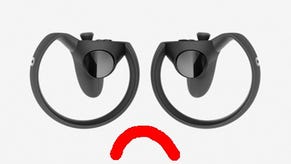Oculus Touch is a superior motion controller to the Vive's
You've got the Touchus
I've been playing with them there Oculus Touch controllers for the last few days - a pair of wireless, motion-tracking handheld devices that, in theory, bring the Oculus Rift more in line with the HTC Vive and its wavy, donut-ended pointers. Turns out they're quite a bit better.
Note: I'm going to focus specifically on the hardware for this piece. Two reasons for that, one being that it is important to separate them, given that software has its own highs and lows, and the other that, er, I don't actually have much software at the time of writing. Some, but not much, so I'll hold back on that side of things for a while.
Here's what you get in the large, luxury-looking cardboard box: two Oculus Touch controllers (FYI I shall henceforth refer to them as 'Touchus', one Oculus sensor (identical to the microphone-shaped unit that comes with the Rift itself), two AA batteries and a small black plastic hoop with 'Rock Band VR' written on it. That last is an exciting prospect indeed, but with no actual use as yet.
I hadn't realised a second sensor would be required for these things, and wasn't overjoyed to take up yet another USB 3.0 port and have yet another dangling cable but at least, unlike the Vive and its three power supplies, I still don't need to connect anything to the wall. The Rift sensors remain relatively subtle and even vaguely attractive, although one either side of a monitor looks odder than just a single unit. Sinister, even.
The extra sensor, as well as meaning that your system can track what the controls are up to, also expands the play area. The Rift has not gone room-scale yet, but it now asks for a 3 foot x 3 foot space, and can track you anywhere within it without any issue I've encountered as yet. This opens up a great deal of potential for Rift software - not the full bounding around that mansion-dwellers can achieve with the Vive, but perhaps something more realistic for more of us. A bit of physicality to support the experience, but not the full monty. Time and software will tell - again, more on that in a follow-up piece.
The controllers themselves are fairly dainty - the hoop area is about the width of an orange, while the more familiar controller part is pretty much the same size as that element of a Playstation pad is. They're light but not too light, and are comfortable in the hand, with the index and middle finger of each hand falling naturally onto a top- and side-mounted trigger respectively.
The thumbstick and three face button arrangements on each controller isn't quite so instinctive - the stick's about half the diameter of those you'd find on a contemporary console pad, while the buttons are both small and close together. I suspect I'd often need to double-check what I'm pressing at the best of times, but that's an impossibility whilst wearing a VR headset.
It's not too bad, and practice will help, but it doesn't entirely feel that there's been the best use of what is relatively generous space on the circular surface of each pad.
A possible reason for that, beyond 'we're big fans of Philippe Starck', is the Touchus' secret weapon - finger-tracking. Not a full five fingers, no sir, but the index finger and to a lesser extent the thumb. While it's very impressive indeed - and useful for combating psychic dissonance - to see yourself do an in-game point or thumbs-up, this is as far as it goes. But nonetheless, the Touch is indeed tracking specific parts of the hand, and the right software may well do incredible things with that.
I'll come back to that side of things later on, but just to return the last point - the sensors to broadly track thumb position are probably why much of the 'face' is effectively blank space with small, clustered controls in the centre.
The same is true of those big, squashed-circle hoops on the end. While the Vive has similar, they jut out several inches beyond the end of your hands, while in this case your index finger and the knuckles of the adjacent couple of fingers sits inside it - with the bulk of the index finger protruding above the 'surface' regardless of whether it's pointing or held down.
This sounds minor, but it's quite a key physical difference from the Vive wands. At the end of your hands is your finger, not a piece of plastic. This means that, when you're 'touching' something inside a VR game, it is your finger - or at least a ghostly recreation of it - that touches that thing, not the plastic hoop.
In the software I do have, this means the likes of holding out a finger for a butterfly to land on, and 'pinching' to hold onto in-game items. Said items are not effectively magnetised onto a protrusion - they are inside your hand. The place where your hand is, as opposed to a place at the end of the 6" stick your hand is holding.
Sure, the Touchus can't do feel (though it has some decent gamepad-style haptic feedback buzzing into your palm), but your in-game hand is more or the less the size and position of your real hand, and that is a gently new sensation.
If you've ever used a Vive, as wonderful as its motion controllers are, you surely know the bleak, hollow sound of the end of them tapping against your monitor, wall, cupboard or cat. With these, when you ram your hand into that cactus or pan full of boiling oil, the sensation will be fleshy-real.
I should restate that these things are completely wireless, without even needing a USB cable or additional dongle for initial setup. Your hands are unfettered, bar the string mentioned below. The downside is that, yeah, no USB cable, because no built-in rechargeable battery. It takes double-As, one per controller, so stock up on batteries if you don't want to find yourself with no way to keep playing when one runs out of juice. (By contrast, the Vive wands are USB-rechargeable, and continue to operate while wired up).
The one concession to practicality over design is a small string hanging from the bottom of each, to slip over your wrist in order that they don't crash to the floor or are hurled at your dog's face when a VR bogeyman jumps out at you. Same as Vive, and Wii, and anything exploring handheld motion controls - health and safety, innit. (I often don't put them on, for the same reason I don't wear my bike helmet for short rides and sometimes freewheel when driving the car down a hill. Gotta make a stand somewhere, right?)
All told, they're a nice item. I really like just holding them, which may not be something I've ever said about a game controller before. The weight's just right, they're comfortable (if perhaps ever so slightly slippy), my hand just falls into place, the trigger and thumbstick movement is nice and, well I suppose it feels vaguely like wearing some kind of cyberpunk knuckleduster.
My fear for these things was that I'd be getting either a differently-shaped Vive wand at best, or a glorified PS Move at worst. I'm glad to say it's both much better than the latter and a more versatile prospect to the former, even if its baseline 'where my hands at?' feature is effectively identical.
As for the in-practice differences, and specifically how it uses its finger tracking 'touch' element, I'll be covering those in a separate piece once I've trialled a few more apps/games.




















